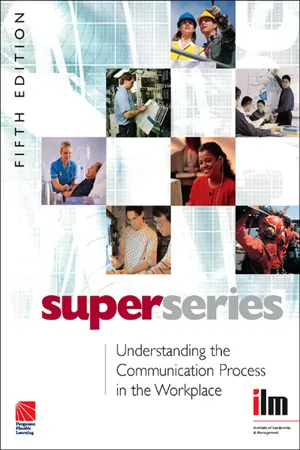Business
Choosing the Right Communication Channel
Choosing the right communication channel involves selecting the most effective method for sharing information within an organization. Factors to consider include the nature of the message, the audience, and the desired level of interaction. Common channels include email, phone calls, video conferencing, and in-person meetings, each with its own advantages and limitations.
Written by Perlego with AI-assistance
Related key terms
Related key terms
1 of 4
Related key terms
1 of 3
5 Key excerpts on "Choosing the Right Communication Channel"
- eBook - ePub
Solutions
Business Problem Solving
- Frank Fletcher, Eric Bolland, Eric Bolland(Authors)
- 2016(Publication Date)
- Routledge(Publisher)
Non-verbal communication is an important part of both written and verbal communication and it can be considered a communication medium in its own right. Body language, posture, eye contact, and facial expressions clue receivers to the subconscious thoughts of the sender. For example, managers who use good posture, appear relaxed but confident, make good eye contact, and smile occasionally, appear to be authoritative and sincere.It is important for written, verbal and nonverbal messages to be consistent and harmonious. Listening to a concert with one of the choir members singing off key detracts from the experience. Similarly, the message can get lost if the sender’s written, verbal, and nonverbal signals are dissonant. For example, if the sales manager’s written message introduces a new service line, but his voice and nonverbal communication suggests doubt about its potential, the sales force may come away from the meeting less than motivated. The resulting impact of incongruent messages may be disastrous for the company.What are the channels of business communication?
Business messages are distributed through communications channels or media. Development of information technologies in recent years has given managers more channel options than ever before. Channels have unique characteristics that meet specific communications needs. For example, interpersonal communication offers more opportunities for face-to-face exchange, while web-based channels allow communication en masse—with potentially millions of people all over the world. Selection of appropriate channels is driven by the purpose of the communication and the size and needs of the organization.Face-to-face interactions provide the best channels for interpersonal communications. These types of interactions may be one-to-one, in small or large group settings, via the telephone, or over the Internet in the form of video-conferencing. Effective interpersonal communications are best achieved in one-to-one or small group settings. Factors that determine the platform for interpersonal communication include purpose of the communication, location of the target audience, time, convenience and budget, many of the same factors described above by Clampitt. Face-to-face communication includes public speaking and in-person presentations. Written, verbal and nonverbal messages may be exchanged via interpersonal communication. - eBook - ePub
- Phil Jones(Author)
- 2017(Publication Date)
- Gower(Publisher)
There was a large amount of media coverage. Whether this was first initiated by the French management, the local management or the unions and workers is unclear.The closures did not affect the French plants. This led to some suggestions that inefficient French plants were being saved by sacrificing the British plants. 3The important thing is to be conscious that these tensions exist. That way you can explain why you were unable to communicate them beforehand.Channels and Their Effectiveness
At the start of this chapter we had the example of an organization that created a communication strategy by documenting the communications channels it currently had. In contrast, we have concentrated on:- Who is important in this strategy?
- What response do you want?
- What do they need to know?
- What are the real connections?
- When do they need to know?
How do we get to these people? What channels exist already and how effective they are? The purpose of your communication channels is to get to as many of your targets, as reliably and quickly as possible and get maximum feedback. So in choosing the channels, there are six main criteria. These are:- Does it provide feedback or is it one way?
- Is it reliable? Can I control the message that passes through it?
- Can I communicate a rich message or only a simple one?
- Will it go to many people or only a few (broadcast or narrowcast)? Will it be a personal or an impersonal message?
- How long does it take to prepare?
- How long does it take to communicate, once it is ready?
The channels split into three main groups. Face-to-face communication channels rely on a personal contact. They include individual meetings, team meetings, large gatherings and conferences, as well as the informal networks.Electronic channels provide a powerful way to get a message out quickly. They include email, phone, messaging, blogging, message boards and discussion forums. In general these are less personal than face-to-face contact, but provide an effective way to get a message out quickly and sometimes reliably, though often with less feedback. - Institute of Leadership & Mana(Author)
- 2013(Publication Date)
- Routledge(Publisher)
The completed grid is not therefore a model which you can apply to any situation, nor does your version have to correspond to it to be right, for there is no right answer applicable to all situations.But what you do need to do is choose the right communication channel objectively for a particular purpose, weighing the pros and cons of each before automatically picking up the phone, sending an email, calling a team briefing – whatever your instinctive preference may be.Activity 19
Look at the following six practical situations and state what you believe would be the right solution to the communication problems they pose.You will find a series of suggestions on page 63, with a short explanation of why they were chosen. No doubt your own recommendations range widely, as mine do, across the available channels, to suit the needs of the situation you are in.1 One of your delivery vehicles has had an accident and you need to advise customers that their deliveries will be affected.2 You are working on a new quality manual and your boss wants to eliminate as much paper as possible.3 You need to send a complicated draft mortgage offer to a client.4 You need to bring your team up-to-date concerning three serious near misses which have happened recently.5 You need to check if seven people from other sites and departments can attend a sales meeting in three days’ time.6 Contractors’ employees have been using the staff restaurant and cloakrooms without authorization.Though your answers may differ to some extent, what really matters is the decision-making process- eBook - ePub
- Elearn(Author)
- 2009(Publication Date)
- Routledge(Publisher)
Communication in organisations is full of contradictions. On the one hand, everyone agrees that it is vitally important – the lifeblood of the organisation. As early as 1916, Henri Fayol, the French engineer, put communication at the centre of his ‘wheel of management activities’. Ask any group of employees what matters most to them and you will almost certainly find ‘good communication’ high on the list.On the other hand, communication is one of the things that organisations most often get wrong. Charles Handy, in Understanding Organisations (1993), gives a list of studies showing how often communication fails to get through. Here are just two examples:Communication isone of the things thatorganisations mostoften get wrong. A study of communication in companies found that information communicated by top management was only remembered by one in five people on the shop floor- In another case study, while 95 per cent of supervisors felt they understood the problems of the people in their teams well, just 35 per cent of their team members agreed.
In their book Understanding Information (1990), Jonathon Liebenau and James Backhouse define communication as follows:Communication is a process which involves at least two parties. This process can be characterised as a set of activities involving a sender with intentions to convey, a medium or channel for carrying signals, and a receiver who has the ability to interpret those signals.Source: Liebenau and Backhouse (1990)Within this broad definition it is important to distinguish between:- spoken and written communication
- verbal and non-verbal communication
- formal and informal communication.
Spoken and written communication
The first key distinction is between spoken communication – where we speak and listen – and written communication – where we write and read. As Stephen Covey comments, managers spend many hours a day speaking, listening, reading and writing:The ability to do them well is absolutely critical to your effectiveness.Source: Covey (1992)Covey highlights the skills of listening as especially important. He points out that we all spend a lot of time at school learning to read, write and speak, but much less learning to listen and in practice it is listening skills that can be especially important to managers. - eBook - ePub
- Brian Roulstone, Jack J. Phillips(Authors)
- 2007(Publication Date)
- Routledge(Publisher)
Communication is one of those important issues that can cause major problems. Because the results of a project can be closely linked to the performance of others and the political issues in an organization, communication can upset some individuals and please others. If certain individuals do not receive the information or if it is delivered inconsistently from one group to another, problems can quickly surface. Not only is it an understanding issue, but it also involves fairness, quality, and political correctness. Always make sure that communication is properly constructed and effectively delivered to all key individuals.AudiencesBecause there are so many potential target audiences for receiving communication on the success of a project, the communication should be tailored to their needs. A varied audience will command varied needs. Planning and effort are necessary to make sure the audience receives all the pertinent information, in the proper format, and at the proper time. A single report for all audiences may not be appropriate. The scope, size, media, and even the actual information of different types and different levels will vary significantly from one group to another, making the target audience the key to determining the appropriate communication process.Collectively, these reasons make communication a critical issue, although it is often overlooked or underestimated in strategic IT and technology development projects. This chapter builds on this important issue and shows a variety of techniques for accomplishing all types of communication for various target audiences.PRINCIPLES OF COMMUNICATING RESULTSThe skills required to communicate results effectively are almost as delicate and sophisticated as those needed to obtain results. The style is as important as the substance. Regardless of the message, audience, or medium, a few general principles apply and are explored next.Use Timely CommunicationUsually, results should be communicated as soon as they are known. From a practical standpoint, it may be best to delay the communication until a convenient time, such as the publication of the next corporate newsletter or the next senior management meeting. Timing issues must be addressed. Is the audience ready for the results in light of other things that may have happened? Is the audience expecting results? When is the best time for having the maximum effect on the audience? Are there circumstances that dictate a change in the timing of the communication?
Index pages curate the most relevant extracts from our library of academic textbooks. They’ve been created using an in-house natural language model (NLM), each adding context and meaning to key research topics.
Explore more topic indexes
Explore more topic indexes
1 of 6
Explore more topic indexes
1 of 4




